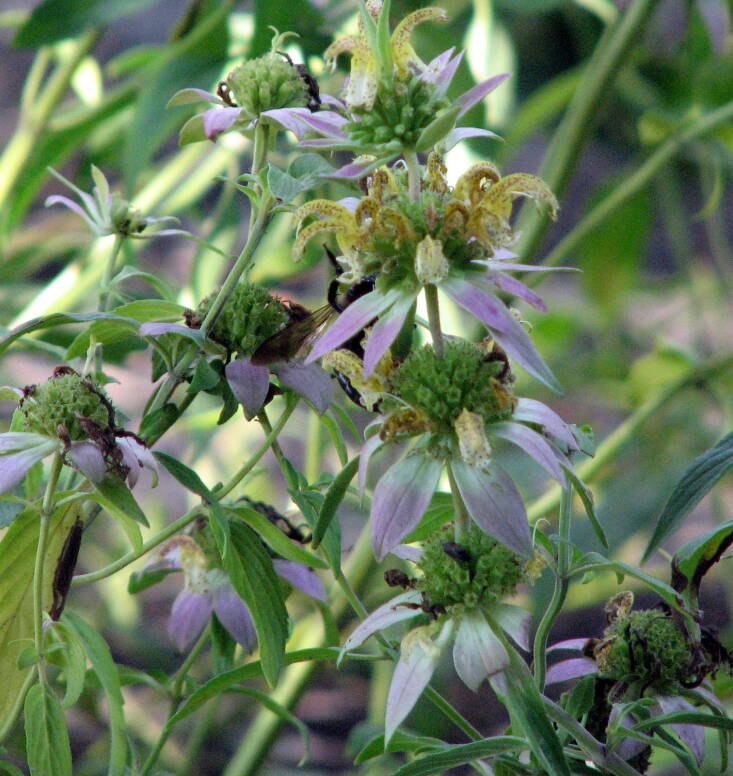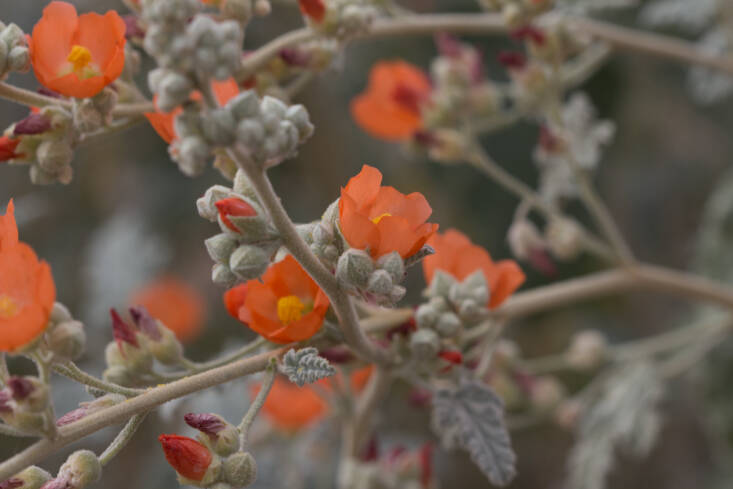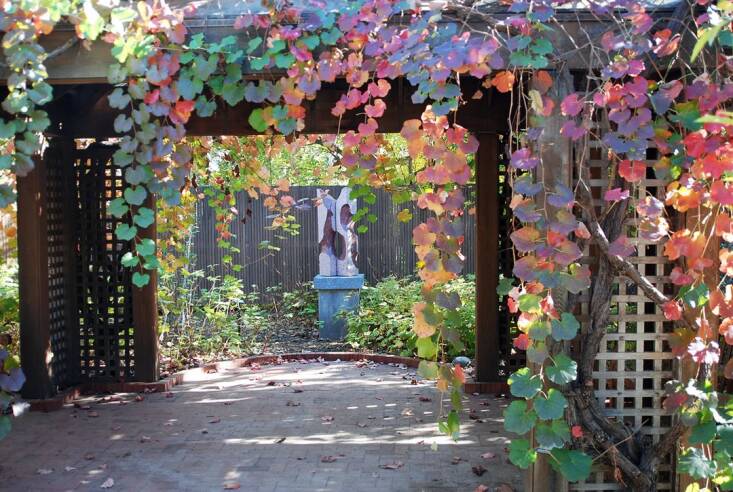If you’re not a paid subscriber to Gardenista and Remodelista, you’re in for a treat this month. Every Sunday until the end of the year, we’re opening up Quick Takes content—normally reserved for subscribers—to everyone. (You can learn more about Quick Takes here. And sign up for a paid subscription by clicking “Join” in the upper right corner of the homepage.)
Today, we’re sharing some of our experts’ answers to Quick Takes prompt “favorite go-to plant.” Here’s what they had to say about the workhorse flowers, shrubs, trees, and edibles that our esteemed garden designers, growers, and makers rely on time and again.
Perennials
Wild Columbine
 Above: Photograph by Marie Viljoen, from Lessons in Green: Manhattan’s Hidden Forest.
Above: Photograph by Marie Viljoen, from Lessons in Green: Manhattan’s Hidden Forest.
“Aquilegia canadensis. Adorable. functional. Adaptable. and charismatic.” —horticulturalist and garden designer Rebecca McMackin
California Buckwheat
 Above: Photograph of white sage and California buckwheat (white flowers) by Jen Toy, from Ask the Experts: 11 Favorite Native Plant Combinations.
Above: Photograph of white sage and California buckwheat (white flowers) by Jen Toy, from Ask the Experts: 11 Favorite Native Plant Combinations.
“Eriogonum fasciculatum. Their inflorescences go from popcorn creamy white to a deep rust color from spring to fall, and it boggles my mind.” —landscape architect David Godshall.
Spotted Bee Balm
 Above: Photograph by bobistraveling via Flickr.
Above: Photograph by bobistraveling via Flickr.
“Monarda punctata. It tends to be short lived—it might act like an annual—but I am willing to replant it as I never tire of its odd combination of wacky complicated bloom and understated presence. Not to mention how many pollinators love it, too.” —Perfect Earth Project founder Edwin von Gal
Cow Parsley
 Above: Photograph by Clare Coulson, from Cow Parsley: An English Weed with Royal Connections.
Above: Photograph by Clare Coulson, from Cow Parsley: An English Weed with Royal Connections.
“Umbellifers. From cow parsley to giant fennel umbellifers have the most pleasing form and are all pollinator magnets. I couldn’t garden without them.” —landscape designer Dan Pearson
Desert Globemallow
 Above: Photograph by Anne Reeves via Flickr.
Above: Photograph by Anne Reeves via Flickr.
“Sphaeralcea ambigua. Desert globemallow is such a carefree, colorful texture to add to any garden. It’s great for pollinators and its pale silvery blue leaf adds a bit of brightness. I like using it at the edges or bases of hedges to brighten the garden. There’s a large variety of mallows, too, so if the orangey color isn’t right for the space, chances are there’s another color that will work.” —landscape designer Molly Sedlacek
Giant Chalk Dudleya
 Above: Photograph via Tree of Life Nursery, from Gardening 101: Dudleya Succulents.
Above: Photograph via Tree of Life Nursery, from Gardening 101: Dudleya Succulents.
“Dudleya britonii, a beautiful chalky white California native succulent.” —nursery owner Flora Grubb
Dahlia
 Above: Photograph by Sarah Raven, from Quick Takes With: Sarah Raven.
Above: Photograph by Sarah Raven, from Quick Takes With: Sarah Raven.
“Always the dahlia—no doubt.” —grower, cook, writer, and entrepreneur Sarah Raven
Edibles
Basil
 Above: African blue basil growing on Marie’s balcony. Photograph by Marie Viljoen, from Gardening 101: African Blue Basil.
Above: African blue basil growing on Marie’s balcony. Photograph by Marie Viljoen, from Gardening 101: African Blue Basil.
“If I was threatened and told I could choose one plant, or else? Basil. I usually grow three or four varieties. All basils smell good, taste wonderful, are long-lasting in a vase, and are loved by pollinators.” —forager, author, and Gardenista contributor Marie Viljoen
Roger’s Red Wild Grape
 Above: A 5-gallon pot of Roger’s Red Wild Grape is $41 at Santa Barbara Botanic Garden.
Above: A 5-gallon pot of Roger’s Red Wild Grape is $41 at Santa Barbara Botanic Garden.
“Vitis ‘Rogers Red’ (grape) and I are having a moment lately. It doubles wonderfully as a shade vine and rambunctious groundcover, with delicious table grapes and crimson leaves in the autumn. Lower water use. Great for florals, too.” —landscape designer Christian Douglas
Shrubs & Trees
Boxwood Balls
 Above: Photography courtesy of Peter Fudge Gardens, from Garden Designer Visit: Lavender Fields in Australia.
Above: Photography courtesy of Peter Fudge Gardens, from Garden Designer Visit: Lavender Fields in Australia.
“Boxwood balls. They seem to solve almost every garden problem.” —gardener and basket weaver Deborah Needleman
Staghorn Sumac
 Above: Photograph by Erin Boyle, from Gardening 101: Sumac
Above: Photograph by Erin Boyle, from Gardening 101: Sumac
“Rhus typhina. For unexpected texture, the staghorn sumac has always delighted our clients. And its fall color is absolutely stunning. The seed heads that form are striking in the winter, so its seasonal interest is abundant. Sometimes we choose plants specifically for their winter interest.” —garden designers Corwin Green and Damon Arrington
Ninebark
 Above: Ninebark ‘Amber Jubilee.’ Photograph by F.D. Richards via Flickr.
Above: Ninebark ‘Amber Jubilee.’ Photograph by F.D. Richards via Flickr.
“Physocarpus. I have a few signature plants here that I like to incorporate in each garden, but by far the most used here at Arkwood is the native shrub ninebark. I’ve got quite a few varieties here and growers keep bringing out beautiful new ones that are fun to collect and trial here in the gardens. Physocarpus ‘Amber Jubilee’ is a standout here at Arkwood from spring to fall and throughout the winter with its shedding bark.” —master gardener and shopkeeper Todd Carr
Hornbeam
 Above: Photograph by Matthew Williams, from Privacy Landscaping: How to Use Plants Strategically in a City Garden.
Above: Photograph by Matthew Williams, from Privacy Landscaping: How to Use Plants Strategically in a City Garden.
“Carpinus caroliniana. Why? They are boring and don’t do shit. Except, they are tall and can be sculpted. This makes them a great screening tool for small urban gardens. For estates and different rural landscapes, I have different tricks. It’s nice to have some boring, reliable things.” —landscape designer Brook Klausing
See also:


